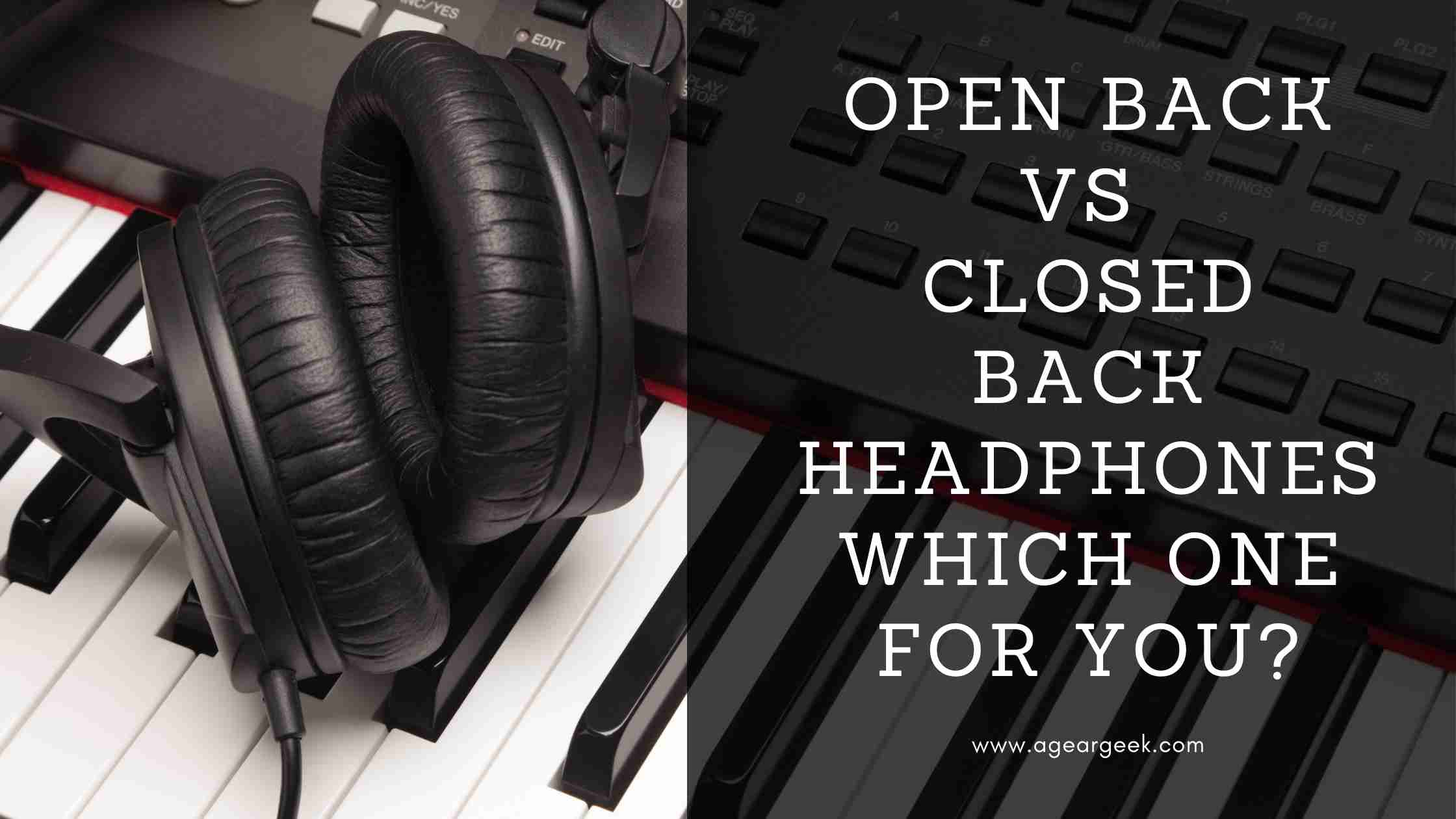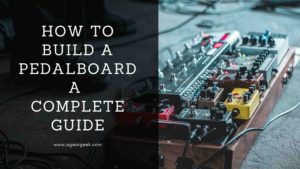Headphones could be expensive investments if you care about high quality. At a slightly mid to high range, the options and variety of headphones open up. Here you are left with the thought of open back vs closed back headphones, and which one is most appropriate for you.
To a layman, it might seem just another headphone but in reality, the usages of these two are very different. A headphone bought for the wrong use can result in it being on the desk forever without getting being used.
In this article we will go understand open back vs closed back headphones and which ones are right for you.
Disclaimer: We’re an affiliate. We hope you love the products we recommend! This post contains affiliate links. If you use these links to buy the products, we may earn a commission from the qualified sales. These are at no additional cost to you. Thank you if you use our links, we really appreciate it!
Closed Back Headphones
Versatile in use
A closed back headphone could be used in various settings and are multiutility equipment from that perspective. It could be used in the studio to record vocals or you could be outside listening to music and still be able to isolate from the outside sound.
The closed back models are easier to be carried and can be plugged into any sound source. Quite flexible from the perspective of usage.
Isolation
The closed back of the headphones does not allow external sound to come and also the sound from the headphones to go out. These headphones are completely sealed and are thus able to provide isolation from the surrounding. Close Backs provide superior isolation as compared to open backs. In addition to this, a lot of closed back headphones have noise-canceling capabilities.
Usages
These are great in the studio when you are tracking different instruments, isolating musicians from the other sounds of the room, and also great in preventing bleeding into the microphones.
These are also great for casual listening, listening in public transports and also in offices. These do not bleed and hence what you hear will not disturb others.
Pros
- Provides superior isolation from the surroundings and providing great detail.
- Easy to use in various surroundings causing the least disturbance to others.
- Some models come with active noise cancellation.
- Have a larger spectrum of price points to choose from. From inexpensive to premium.
Cons
- These tend to be uncomfortable to be worn over a longer period of time.
- It accumulates moisture and heat inside the ear cups.
- Feels tighter over the ears and head.
Open Back Headphones
Made more for professional use.
On the other hand, the open back headphones are more premium and they sound better, hands down! Due to the open back structure of these headphones, they are a lot more comfortable for longer use. These headphones do not have a restrictive barrier for sound from escaping the driver. It also lets air to penetrate your listening space or the headphone case. In that way, they do not provide much isolation from the surrounding.
Expansive & Natural Sounding
These make you feel a lot more relaxed and comfortable. Music feels a lot more expansive and natural around you due to the openness of these headphones.
Usage
Open back headphones bleed into microphones if used during the recording such as vocals or acoustic guitars. These are not recommended to be used for such recording sessions. But these are great for mixing and no wonder most of the mixing professionals would use open backs.
These could also be used in a private space for an uplifting sonic experience. Not the best to be used in offices or public transport as others in the surrounding will also hear what you are listening to. It may disturb the surrounding people.
Accurate and Transparent Sounding
These provide a better spatial experience that is close to reality. Open backs have the ability to provide you with an accurate sound to place different components of a track on a digital sound space and in a clear stereo field. It provides a superior depth for mixing purposes.
Pros
- Provides a more expansive and natural sound. A fuller superior quality of sound.
- Great for sound mixing and professional use.
- Provides a comfortable experience even if worn for long hours.
Cons
- Does not provide the best isolation from the surrounding.
- Sound bleeds out of the headphones and can disturb others in the surrounding.
- Not so versatile to be used in different surroundings.
What you need to look for when choosing any headphone
There are two main things which distinguishes headphones and these are the headphone drivers and the frequency response.
What is headphone driver
The headphone driver is in other words are the speakers of the headphone. If you compare it with a two-way studio monitor, the drivers will be the woofer and the tweeter.
Just like a studio monitor, the driver in a headphone plays a very important role in delivering superior sound quality.
The components of the driver are the magnet, voice coils and a diaphragm. The driver size is dependant on the headphone but usually between 20 mm to 50 mm.
Sound in a dynamic headphone is produced by creating a magnetic field that enables the voice coil to move the diaphragm and displace air and thus creating sound. The larger the air displacement, the louder is the volume.
The size of the driver reales to how big the sound and the bass. It does not have a bearing on the quality of sound. A bigger driver will be able to deliver a better bass and will be louder than a smaller one.
Types of drivers
There are primarily five types of drivers.
Dynamic or moving coil
These are the most common drivers and the cheapest as well. These work by creating a magnetic field and producing sound by displacement of air by the diaphragm.
Balanced Armature
These are more expensive than dynamic drivers and are found in in-ear monitors. These can tune to specific frequencies and one IEM can have as many as four different drivers to complete the spectrum of sound.
The main difference between a Balanced Armature and Dynamic Drivers is that the former does not displace air to produce sound. As a result, this produces a reduced bass response. For this reason, there are IEMs with Dynamic Drivers as a combination to compensate for the bass. The IEMs also provide better isolation.
No products found.
Planar Magnetic
These are found more on the open back designs. These drivers are associated with the premium models of headphones and are extremely thin in nature. Planar drivers work on similar principle as Dynamic Drivers.
These drivers have larger or more magnets and thus are heavier or bulkier. These may also need additional power through an external amp and are thus are not portable and are used best in a home or studio environment. The sound quality from these drivers are of high quality with low distortion clean sound.
No products found.
Electrostatic
These drivers are more complex and works on the basis of static electricity. These drivers need specific amplifiers called energizers and are found in premium open back headphones.
While they sound great and provide a life-like soundstage experience but they are not portable and best used in a studio or home surroundings. The quality of sounds comes at a price and these are not cheap.
No products found.
Magnetostriction or bone conduction
These drivers bypass the eardrum and send the frequency to the inner ear through bone conduction. These are especially helpful for cases where the ears need to be kept unobstructed. For example, a jogger to be aware of oncoming traffic.
No products found.
Frequency Response
The human ear can hear between frequencies of 20 Hz to 20 kHz. A frequency response means how the different frequencies on the spectrum are reproduced.
This is done by measuring the volume or SPL at different frequency ranges. This will give you an understanding if you are looking at a headphone that is bass-heavy or high on treble or mids.
So, which one is right for you?
Now with a good background on the usage of both open back vs closed back headphones, I hope you are able to decide which one suits you the best.
If you are a casual listener, prefer to listen to music while commuting or listing to music while working in the office, then getting a closed back headphone will be the most appropriate for you.
On the other hand, if you have a home studio where you like to mix tracks, and also enjoy music in seclusion then the open backs can be a great option. These are also fantastic options for professional sound engineers as well.
What are some of the best Close Back Headphones
Table could not be displayed.What are some of the best Open Back Headphones
Table could not be displayed.Conclusion
So we have seen that both open back vs closed back headphones have their place depending on what you want to achieve. Headphones are personal choices, just like buying studio monitors.
Go for an open back if you are a music creator or have a home studio. If you just want to enjoy music, then a closed back with active noise cancellation is a great choice.
Last update on 2025-06-03 / Affiliate links / Images from Amazon Product Advertising API






Pingback: Best headphones for guitar amps and practice - A Gear Geek